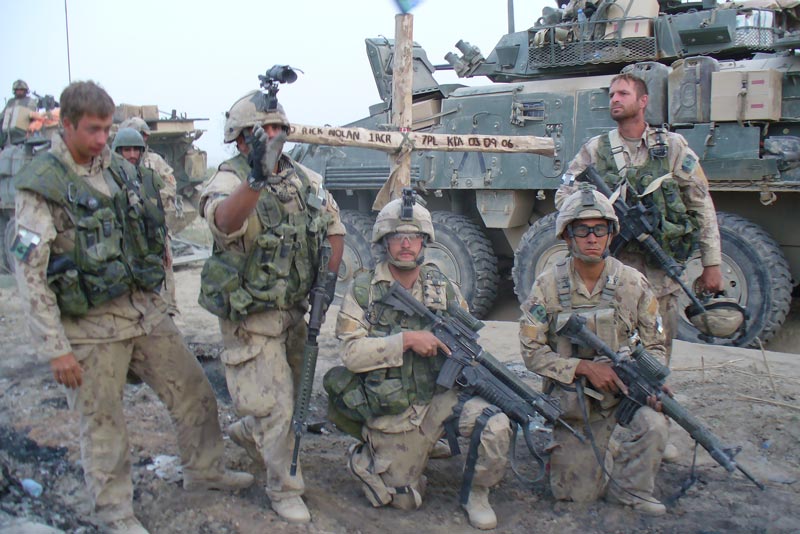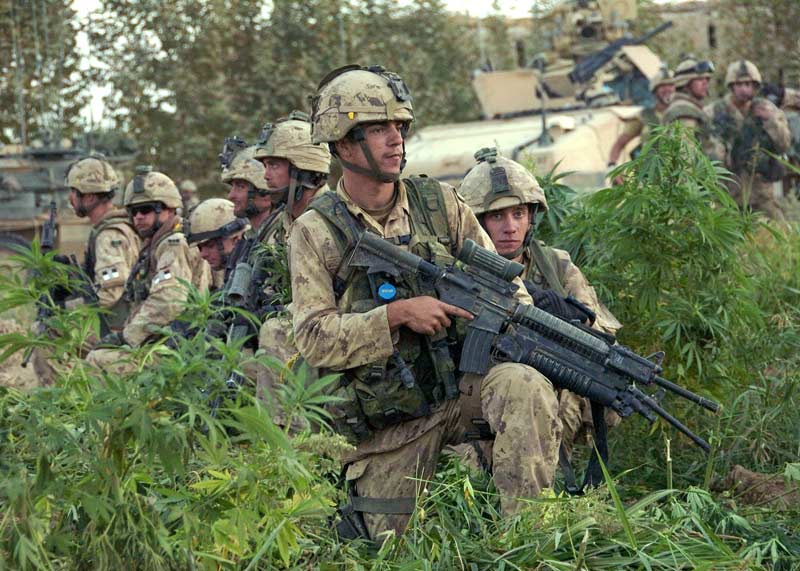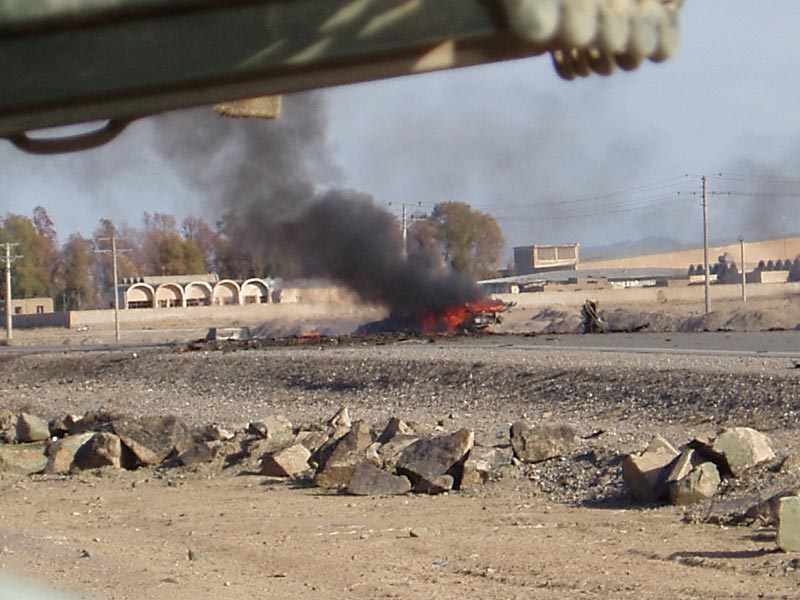
Cpl. Sean Teal (centre) at the spot where WO Rick Nolan was killed on Sept. 3, 2006. From left are Capt. Derek Wessan, Pte. Varant Sarmazian, Teal, Cpl. Jason Funnell and Sgt. Scott Fawcett. [Courtesy of Sean Teal]
The last thing Corporal Sean Teal said to Warrant Officer Rick Nolan was: “Do you want a Life Saver?”
Before Nolan could reply, a rocket-propelled grenade (RPG) fired by a Taliban fighter struck the windshield of their G-Wagon and killed him. Teal, driving in the seat right next to him, was concussed but functional.
“All of a sudden, wham, there was this huge flash and I was smashed back in my seat,” Teal recalled in an interview with Legion Magazine. “Everything just went black. All you could smell was burning plastic and burning hair and it was like there was no air.
“I went to hit the pedals and there was nothing. It was like the vehicle just shut off. Then there was this barrage of machine-gun fire coming in.”
They call it “the mad minute,” those first moments of an ambush when the attackers try to impose as much possible damage on a surprised, momentarily disorganized and relatively defenceless enemy.
It was Sept. 3, 2006, and Teal was at the point position, at the forefront of about 80 members of 1st Battalion, Royal Canadian Regiment, who were attempting for the second time in a month to take the White School in Pashmul, Afghanistan. The school is said to have been the site where the Taliban became a formal entity; it was now a fortified enemy staging point and they had put up a strong fight when Princess Patricia’s Canadian Light Infantry tried to take it in early August.
Sean Teal would earn a Star of Military Valour that September day. Now a group of military veterans assessing the medals awarded to Canadian soldiers in Afghanistan is asking Ottawa to consider him for the Victoria Cross.
He didn’t know it yet, but an estimated 250 enemy fighters were right in front of him.

Members of 2 Platoon, Bravo Company, 1RCR, prepare to storm a compound during Operation Medusa in Zhari District, near Kandahar on Sept. 4, 2006. [MCpl Yves Gemus/DND]
The very fact the Canadians had been dispatched that morning had come as a surprise to most of them. They had expected three days of artillery and air strikes before launching the offensive at the outset of Operation Medusa. They got one day’s worth of munitions support and set out on a few minutes’ notice, without breakfast, many of them still donning their kit as they mounted up—Teal included.
Up to 400 fighters awaited them, closing a U-shaped trap around the Canadians as they forded a river and crossed a field of marijuana taller than full-grown cornstalks. Teal pulled up less than 50 metres from the single-storey building.
He didn’t know it yet, but an estimated 250 enemy fighters were right in front of him. The rest of his 7 Platoon was somewhere behind and would soon be engaging other fighters.
It wasn’t long before all hell broke loose. The Taliban had RPGs, AK-47s, .50-calibre machine guns and Soviet-made 82-mm recoilless rifles. It would be the biggest firefight involving Canadians since the Korean War.

Soldiers of Alpha Company, 2PPCLI, part of the Canadian battle group, conduct operations in the Panjwaii District of Kandahar Province on Sept. 14, 2006, during Operation Medusa. [Sgt. Lou Penney/DND]
“One person trying to kill you is alarming,” said Teal, a native of Cole Harbour, N.S., now living outside of Stewiacke. “Hundreds of people trying to kill you with machine guns and RPGs is a whole other thing.
“When that happened to me, when I kicked that door open and it was real, nothing else in the world existed. It was what was right in front of me. All of the training kicks in and you have to realize, when there’s somebody dead right next to you, that this is the real thing. They already gave their life and it’s my job to give my life to get this situation under control. You have to be completely selfless and you have to just convince yourself that, you know what, if I die in the process, so be it.”
He opened the back door. Inside, the platoon medic, Cpl. Richard Furoy, and an Afghan interpreter were wounded and struggling to extricate themselves.
The marijuana fields spread in all directions. They couldn’t have been in a worse position.

At first light, soldiers from Alpha Company, 2PPCLI, part of the Canadian battle group, conduct operations in the Panjwaii District of Kandahar Province on Sept. 14, 2006, during Operation Medusa. [Sgt. Lou Penney/DND]
Somewhere ahead, an engineers’ LAV III had also been hit, and Sergeant Shane Stachnik, 30, was dead.
Teal fired his M203 grenade launcher, killing the fighter whom he believes fired the RPG and wounding another who was helping him reload. Other Taliban fighters were regrouping and taking positions in front of Teal; he sprayed the area with rounds. Teal said for the most part, however, the enemy were “like ghosts”—he could see muzzle flashes and smoke but not them.
He looked at Nolan in the front passenger seat. He was lying back, his head angled toward him. His helmet was gone. At that point, all Teal knew was that he was unconscious and the vehicle was on fire.
“I grabbed the medic as he got out and he’s got no rifle,” said Teal. “He’s really, really concussed, you can see it. You can see this look of almost fatigue and exhaustion but it’s not; it’s just concussion.”
He pushed the wounded man toward the back of the vehicle; his left arm was purple. Teal had no time to attend to anyone. The interpreter, his face covered in blood, one eye drooping unnaturally and his ear dangling by a thread of skin, fell out onto his head. Teal grabbed him and pulled him to the back. Bullets were snapping into the jeep, kicking up dirt, and whizzing past them the whole time.
“The rounds kept coming in. But I had to get Rick out.”
8 Platoon was off to his right in a firefight of their own. He could hear friendly weapons firing but Teal couldn’t see a friendly face.
Teal made his way around to the right side of the vehicle. He fired about 20 rounds from his C7 rifle and launched another grenade, to no discernable effect.
“It didn’t change a thing,” he said. “The rounds kept coming in. But I had to get Rick out. At no point did I ever [consider any other option]. I’m getting him out; you don’t leave anybody behind. I don’t know if I could live with myself if I didn’t try. You owe it to them. This is your family…and when they go, you feel it.”
There was no covering fire. Teal was alone and exposed.
He slung his weapon, grabbed the door and yanked it open. You can’t throw open the heavy door on a G-Wagon—it will just bounce back; it has to be pressed to its maximum radius. As he did so, a bullet smashed into the glass between his upper hand and his head.
He looked inside. There was a hole the size of a medicine ball in the windshield in front of Nolan. The rest of the glass was a shattered mess. The dashboard was completely gone. Their communications equipment and virtually everything else around it was on fire, including Nolan and his carbine.
Teal grabbed the weapon and threw it clear. Then he started slapping out the fires. What glass was left offered no protection from the hail of fire. Machine-gun rounds were passing through the vehicle. Teal’s vacated seat was riddled. He grabbed the 39-year-old Nolan and carefully pulled him out, still unsure of his comrade’s fate.
They landed in the dirt, Nolan’s pants still burning. The door slammed shut from the impact of enemy rounds. Teal started pulling Nolan to the back of the vehicle, their progress slowed by the warrant’s weight and the fact his dragging feet kept catching in the tangled marijuana stalks the vehicles had flattened.
“I had no time to think about my safety,” said Teal. Once he got Nolan to the back of the G-Wagon, he tried to align his motionless body with the tire rims in order to protect him from the hailstorm coming from the enemy positions ahead of them.
“I put him on the ground and I looked at his face. He had injuries; right away [I thought] these should be fatal. When I went to check for his dog tags I pulled his gear down. He had an injury that nobody on this planet could live from.”
At that point, his thoughts shifted to getting Nolan’s body off the battlefield and saving the two wounded men alongside him.
He started waving, not knowing if anyone could see him. He had a small radio but the ringing in his ears was still so loud from the RPG blast and the noise of the battle that he couldn’t hear anything else.
Eventually, a LAV pulled up behind them—at least half a football field away—and Teal made eye contact with two of his section mates, including his section commander, Sgt. Scott Fawcett. Just knowing someone knew they were there and in trouble was a comfort.

A LAV III of the Canadian battle group moves through a breach in the Panjwaii District of Kandahar Province as part of Operation Medusa. [Sgt. Lou Penney/DND]
“Now I had a second gun on this vehicle and that is an amazing feeling, to not be alone.”
He grabbed Furoy and shook him, then smacked his helmet. It was of no use. Teal ran and grabbed Nolan’s C8 carbine, still lying in the field of fire. Then he butt-struck Furoy with it. It worked. The medic came to, and Teal handed him the weapon.
“It was like waking him up from a dream,” said Teal. “He looks up at me and his eyes are wide open. I just yelled at him: ‘Enemy 50 metres to your front! Defend yourself!’ He dragged Rick’s gun—his injury was to his left side and he was right-handed—and he had the gun up.
“Now I had a second gun on this vehicle and that is an amazing feeling, to not be alone.”
They engaged the enemy with a steady stream of fire. Teal still has no idea how long they did so—“seconds feel like minutes and minutes feel like hours.”
Behind them, Fawcett grabbed Cpl. Jason Funnell and Private Michael O’Rourke. The three soldiers came running through the marijuana plants. All three would receive the Medal of Military Valour for their actions that day.

Members of the Canadian battle group take up positions among marijuana plants in the Panjwaii District of Kandahar Province on Sept. 14, 2006, during Operation Medusa. [Sgt. Lou Penney/DND]
The pair took up fire positions while Funnell and O’Rourke ran the two wounded men back across the field under heavy fire, one wounded man at a time. That’s two round trips—in, out, back in and out again.
Another LAV came in on the left rear to pick up the remaining soldiers—backing to within 15 metres to minimize the troops’ exposure as they boarded the heavy, eight-wheeled vehicle via the ramp in the rear. The inside of the LAV was exposed to the enemy.
Teal and Fawcett dragged Nolan’s body back and in, all while under heavy fire. “It worked,” said Teal. “It’s what saved the day for us.”
The heavily armed LAV, he said, “is the best thing we have on the battlefield, by far. It’s home; it’s your lifeline.”
Rather than hitch a ride to safety, however, Teal and Fawcett returned to the G-Wagon. The LAV raised the ramp and took off with their comrade’s body aboard.
The two soldiers resumed the fight.
“Everything you do out there has to be maximum violence,” explained Teal. “But you have to be careful about it. You can’t outrun a bullet, and those people, they’re willing to die for what they believe in and they’re merciless.
“And you know what? That’s what war is. There is no mercy.”
The pair took up positions behind the vehicle and began “burning off ammo.”
“It’s being depleted. The vehicle’s on fire. Any gear that was in that vehicle would have been absolutely Swiss cheese. That was it; there was no point in staying there. So we pulled off some rounds and then hoofed it back, probably close to 75 metres blindly through the marijuana field.”
They arrived to find the rest of 7 Platoon in the midst of a firefight of their own. Teal had a tactical combat casualty course under his belt, so in spite of his own injuries, he went from vehicle to vehicle looking for other wounded to help.
Furoy, meanwhile, was helping others.
Teal came across Pte. William Cushley, 21, lying face-down in the dirt. He was dead, and his bereaved and angry section was around their particularly beloved comrade-in-arms pouring fire onto the enemy positions.
A few soldiers loaded Cushley’s body onto a LAV and resumed the fight.
Teal found his way to the field commander’s LAV and reported to Captain Derek Wessan that all casualties had been recovered. Wessan took a smoke grenade and pitched it—a signal for time to go.
Just as he did so, the Canadians looked up to see a giant “football” coming into their position. It was a 1,000-pound bomb.
“It bounced and landed and it didn’t go off. It ended up out in front of our position. At that point, it’s not safe for anybody out there. If that thing goes off, you’re in a real mess. So between the casualties that we had, the gear that we lost, the order to pull back came over the radio.”

From left: WO Rick Nolan, Sgt. Shane Stachnik, WO Frank Mellish, Pte. William Cushley and Pte. Mark Graham were among 12 Canadians killed in action during Operation Medusa. [DND]
There was no room left in any of the vehicles so Fawcett and Teal ran nearly 400 metres back, wading chest-deep through the river, to the assembly point.
Teal was exhausted and dehydrated. He had a massive concussion and the RPG blast had injured his back—wounds he still struggles with today. He had no water. He was down to his last 13 rounds of ammunition.
When they reached the casualty collection point, they stripped down and inspected each other for undetected wounds—a common occurrence in combat, where adrenaline readily overcomes pain.
His fellow soldiers were staring at Teal. “How the hell did you not get hit?” they asked. His tactical vest had a number of holes—from bullets and shrapnel.
The doctors told him to stay awake. He was so exhausted, he couldn’t. The next day, Teal was back on the battlefield after an American A-10 Warthog accidentally strafed the Canadian position, killing former track-and-field Olympian Pte. Mark Anthony Graham and wounding 36 others.

A member of 2 Platoon, Bravo Company, 1RCR conducts a nighttime patrol in Zhari District, near Kandahar on Sept. 5, 2006. [MCpl Yves Gemus/DND]
The day after the coalition claimed victory a suicide bomber killed four Canadians on patrol. Henceforth, the Taliban would avoid head-to-head battles wherever possible, instead exacting its toll by land mine, suicide bomber and improvised explosive device, thus minimizing their own losses.

The aftermath of a foiled suicide bombing on Teal’s platoon shortly before they departed Afghanistan for home. The bomber survived the blast but not the wrath of the RCR. [Courtesy Sean Teal]
“We killed a lot of people over there,” he said. “And we have issues. And these people [clinicians] don’t know anything about it.
“It’s hard to get sympathy or empathy from people who can’t relate. And it really set me back. I stopped trusting the system.”
No Victoria Cross has been awarded to a Canadian since the Second World War. In February 1993, Canada followed Australia’s precedent and established its own VC, its distinctive cross impressed with the Latin motto “Pro Valore” instead of “For Valour,” thus avoiding the need to squeeze Canada’s two official languages onto the scroll that bears it. New Zealand followed suit with its own medal in 1999.
The group Valour in the Presence of the Enemy, comprised mainly of Afghanistan veterans, has compiled lists of potential VC recipients, both modern-day and historical, which they intend to detail in a pair of documentaries they hope to air in a future remembrance period. Teal stands near the top of those lists.
—
Next week, Sean Teal’s unique insights on PTSD. Meanwhile, read Adam Day’s definitive three-part account of Operation Medusa, starting here.
Advertisement





















